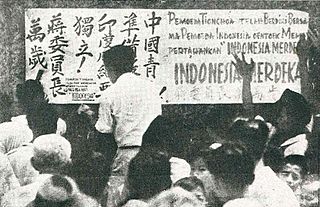
This article is about the demographic features of the population of Hong Kong, including population density, ethnicity, education level, the health of the populace, religious affiliations, and other aspects of the population.

This is a demography of Mongolia including population density, ethnicity, education level, health of the populace, economic status, religious affiliations and other aspects of the population.

The Demographics of Tajikistan is about the demography of the population of Tajikistan, including population growth, population density, ethnicity, education level, health, economic status, religious affiliations, and other aspects of the population.

Overseas Chinese refers to people of Chinese birth or ethnicity who reside outside Mainland China, Hong Kong, Macau, and Taiwan. As of 2011, there were over 40.3 million overseas Chinese.

Chinese Indonesians and colloquially Chindo or just Tionghoa are Indonesians whose ancestors arrived from China at some stage in the last eight centuries. Chinese Indonesians are the fourth largest community of Overseas Chinese in the world, followed by Chinese Americans. Chinese Indonesian are also seen to be dominant in the business sector of the Indonesian economy.

A nationwide census, known as Census 2001, was conducted in the United Kingdom on Sunday, 29 April 2001. This was the 20th UK census and recorded a resident population of 58,789,194.

The Harari Region, officially the Harari People's National Regional State, is a regional state in eastern Ethiopia, covering the homeland of the Harari people. Formerly named Region 13, its capital is Harar, and the region covers the city and its immediate surroundings. Harari Region is the smallest regional state in Ethiopia in both land area and population. Harari and Oromo are the two official languages of the region. The region was created by splitting the Hundane woreda from East Hararghe Zone. As a result, Harari Region is enclaved by Oromia.

The Greek diaspora, also known as Omogenia, are the communities of Greeks living outside of Greece and Cyprus. Such places historically include Albania, North Macedonia, parts of the Balkans, southern Russia, Ukraine, Asia Minor, the region of Pontus, Eastern Anatolia, Georgia, the South Caucasus, Egypt, southern Italy, and Cargèse in Corsica. The term also refers to communities established by Greek migration outside of these traditional areas; such as in Australia, Chile, Canada and the United States.

The Assyrian diaspora refers to ethnic Assyrians living in communities outside their ancestral homeland. The Eastern Aramaic-speaking Assyrians claim descent from the ancient Assyrians and are one of the few ancient Semitic ethnicities in the Near East who resisted Arabization, Turkification, Persianization and Islamization during and after the Muslim conquest of Iraq, Iran, Syria and Turkey.

Bogor Regency is a landlocked regency (kabupaten) of West Java, Indonesia, south of DKI Jakarta. Covering an area of 2,986.20 km2, it is considered a bedroom community for Jakarta, and was home to 5,427,068 people at the 2020 census. The official estimate as at mid 2022 was 5,566,838. Its administration is located in the town of Cibinong.
Ejerie is a woreda in Oromia Region, Ethiopia. Part of the West Shewa Zone, it is bordered on the south by the Southwest Shewa Zone, on the west by Dendi, on the northwest by Jeldu, on the north by Meta Robi, on the northeast by Adda Berga, and on the east by Walmara. The major town in Ejerie is Ejerie town, after which the District is sometimes named.
Kersana Malima or Kersa and Malima, is a Aanaa in Oromia, Ethiopia. Part of the Southwest Shewa Zone, Kersana Mailma is bordered on the south by the Southern Nations, Nationalities and Peoples Region, on the west by Kokir, on the northwest by Tole, on the northeast by Sebeta Hawas, and on the east by the East Shewa Zone; the Awash defines the boundary between this woreda and Alem Gena and the Misraq Shewa Zone. The major town in Kersana Malima is Leman. Sodo Dacha woreda was separated from Kersana Malima.
Babile is one of the districts in the East Hararghe Zone of Oromia Region in Ethiopia. It is named after one of the 12 major clans of the Oromo people, the Babille Oromo. Part of the East Hararghe Zone, Baabile is bordered on the south and east by the Somali Region, on the west by Fedis, and on the north by Gursum; the Fafen River defines a portion of Babille's eastern border. The administrative center of this woreda is Babille Town.
Adola is one of the Aanaas in the Oromia of Ethiopia. It is part of former Adolana Wadera woreda what was divided for Adola, Girja and Wadera woredas and Adola town. Part of the Guji Zone, Adolana Wadera was bordered on the south by Liben, on the southwest by Odo Shakiso, on the west by Bore, on the north by the Southern Nations, Nationalities, and Peoples Region, and on the east by the Bale Zone.
The English people are an ethnic group and nation native to England, who speak the English language, a West Germanic language, and share a common history and culture. The English identity is of Anglo-Saxon origin, when they were known in Old English as the Angelcynn, meaning race or tribe of the Angles. Their ethnonym is derived from the Angles, one of the Germanic peoples who migrated to Great Britain around the 5th century AD.
Asian people are the people of Asia. The term may also refer to their descendants.

Overseas Indians, officially Non-Resident Indians (NRIs) and Overseas Citizens of India (OCIs) are Indians who live outside of the Republic of India. According to the Government of India, Non-Resident Indians are citizens of India who are not living in the country, while the term People of Indian Origin (PIOs) are people of Indian birth or ancestry who are not citizens of India, but are citizens of other nations and may additionally have Overseas Citizenship of India (OCI), with those having the OCI status known as Overseas Citizens of India. According to a Ministry of External Affairs report, there are 32 million NRIs and OCIs residing outside India and overseas Indians comprise the world's largest overseas diaspora. Every year 2.5 million Indians migrate overseas, which is the highest annual number of migrants in the world.

The Hazara people are an ethnic group who are mostly from Afghanistan, primarily from the central regions of Afghanistan, known as Hazarajat, they established a large diaspora that consists of many communities in different countries around the world as part of the later Afghan diaspora. There are currently a million Hazara who live in the Balochistan province of Pakistan mostly in Quetta, many of whom have been settled in the country for generations and are now Pakistani citizens. A similarly large Hazara community is also present in Mashhad, Iran, as part of the Hazara and Afghan diaspora.

The Javanese diaspora is the demographic group of descendants of ethnic Javanese who emigrated from the Indonesian island of Java to other parts of the world. The Javanese diaspora includes a significant population in Suriname, with over 13% of the country's population being of Javanese ancestry. Other major enclaves are found in Australia, French Guiana, Malaysia, the Netherlands, New Caledonia, Singapore, South Africa, and Sri Lanka.











